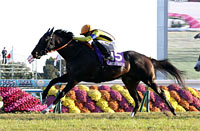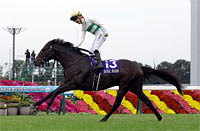Mile Championship (G1) - Data Analysis
Stellar runners from different generations converge to contest the title of champion miler
Gran Alegria secured her fourth G1 victory in the Mile Championship in 2020, and received the JRA Award for Best Sprinter or Miler in the same year. Since all JRA G1 races with a distance of 1,600m or less have been won by different runners this year, the outcome of the Mile Championship is likely to have a major impact on the battle for this year's JRA Award for Best Sprinter or Miler. In addition, Gran Alegria was backed as race favorite by win odds of 1.6 last year, but this was the first race favorite to secure such a victory since Company in 2009. To determine the direction of this highly anticipated battle that is no stranger to upsets, let's now analyze some features shared by successful runners in this race based on results in the last 10 years.
Focus on racing record since Yasuda Kinen
Of the 30 Top 3 finishers in the last 10 years, 25 had experience of finishing within the Top 6 of "a JRA G1 or G2 race held since June of the same year with a field of 13 or more runners." Conversely, runners without such experience struggled with a Top 3 ratio of 5.1%, and that percentage is even lower if we limit our analysis to the eight years since 2013, when performance was [1-1-0-78] (Top 3 ratio of 2.5%). This year again, therefore, we should focus on runners that have performed well in a G1 or G2 race held since June, when the Yasuda Kinen took place. [Table 1]
[Table 1] Performance by experience of finishing within the Top 6 of "a JRA G1 or G2 race held since June of the same year with a field of 13 or more runners." (last 10 years)
| Experience |
Performance
[1st-2nd-3rd-4th or lower] |
Win ratio |
Top 2 ratio |
Top 3 ratio |
| Yes |
7-9-9-54 |
8.9% |
20.3% |
31.6% |
| No |
3-1-1-93 |
3.1% |
4.1% |
5.1% |
Fillies and mares struggle somewhat
Of the 30 Top 3 finishers in the last 10 years, 27 were colts or geldings. Conversely, fillies and mares struggled somewhat with a Top 3 ratio of 10.0%. Moreover, if we limit our analysis to the eight years since 2013, the performance was [1-0-0-22] (Top 3 ratio of 4.3%), and the last runner in this group to finish in the Top 3 was Gran Alegria in 2020. This basically suggests that we should focus on colts and geldings. [Table 2]
[Table 2] Performance by gender (last 10 years)
| Gender |
Performance
[1st-2nd-3rd-4th or lower] |
Win ratio |
Top 2 ratio |
Top 3 ratio |
| Colts or geldings |
9-10-8-120 |
6.1% |
12.9% |
18.4% |
| Mares or fillies |
1-0-2-27 |
3.3% |
3.3% |
10.0% |
Strong performers last time out have an edge
Of the 30 Top 3 finishers in the last 10 years, 27 had finished in the Top 5 of their previous race. Meanwhile, runners that had finished 6th or lower struggled with a Top 3 ratio of 4.1%, and the last runner in this group to finish in the Top 3 was 2014 winner Danon Shark. This means we should lower our expectations of runners coming straight from a major defeat. [Table 3]
[Table 3] Performance by finish in previous race (last 10 years)
Finish in
previous race |
Performance
[1st-2nd-3rd-4th or lower] |
Win ratio |
Top 2 ratio |
Top 3 ratio |
| Top 5 |
8-9-10-76 |
7.8% |
16.5% |
26.2% |
| 6th or lower |
2-1-0-71 |
2.7% |
4.1% |
4.1% |
Focus on runners with 20 or fewer career starts
Of the 30 Top 3 finishers in the last 10 years, 28 had 20 or fewer career starts. Conversely, runners with 21 or more career starts struggled with a Top 3 ratio of 2.9%, and the last runner in this group to finish in the Top 3 was Danon Shark (3rd in 2013 and 1st in 2014). In other words, we should lower our expectations of runners with 21 or more career starts. [Table 4]
[Table 4] Performance by total career starts (last 10 years)
| Total career starts |
Performance
[1st-2nd-3rd-4th or lower] |
Win ratio |
Top 2 ratio |
Top 3 ratio |
| 20 or fewer |
9-10-9-81 |
8.3% |
17.4% |
25.7% |
| 21 or more |
1-0-1-66 |
1.5% |
1.5% |
2.9% |
Body weight is a decisive factor
All 18 Top 3 finishers in the last six years entered their previous race with a weight of "460 to below 520kg." This means we should be cautious about light horses and extremely heavy horses. [Table 5]
[Table 5] Performance by body weight in previous race (last six years)
| Body weight in previous race |
Performance
[1st-2nd-3rd-4th or lower] |
Win ratio |
Top 2 ratio |
Top 3 ratio |
| Less than 460kg |
0-0-0-14 |
0% |
0% |
0% |
| 460kg to below 520kg |
6-6-6-59 |
7.8% |
15.6% |
23.4% |
| 520kg or more |
0-0-0-15 |
0% |
0% |
0% |
Seek out the winner!
Favoritism in previous race is also a key factor
The recent six winners had all been backed as 3rd favorite or higher in their previous race. This means we should be skeptical of runners that were poorly favored last time out. Other shared features among the last six winners were that they had finished 5th or higher in their previous race, that they had 20 or fewer careers starts, and that they had entered their previous race with a weight of "460 to below 520kg." This suggests we should also keep an eye on the trends shown in Tables 3, 4 and 5. [Table 6]
[Table 6] Winners' performance by favoritism in previous race, finish in previous race, total career starts, and body weight in previous race (last six years)
| Year |
Winner |
Favoritism in previous race |
Finish in previous race |
Total career starts |
Body weight in previous race |
| 2015 |
Maurice |
1st favorite |
1st |
11 |
510kg |
| 2016 |
Mikki Isle |
2nd favorite |
2nd |
18 |
486kg |
| 2017 |
Persian Knight |
2nd favorite |
5th |
8 |
476kg |
| 2018 |
Stelvio |
3rd favorite |
2nd |
8 |
468kg |
| 2019 |
Indy Champ |
3rd favorite |
3rd |
11 |
476kg |
| 2020 |
Gran Alegria |
1st favorite |
1st |
9 |
504kg |
(Masaya Ibuki)
|




















